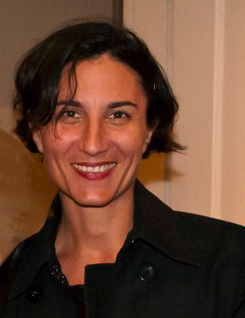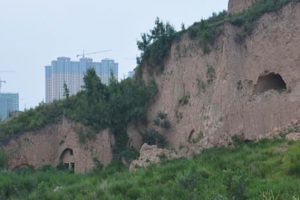Teaching Architecture is a series of interviews with faculty at the University of Waterloo School of Architecture. Graduate student Sneha Sumanth asks professors why they teach, what drives them, what brought them here, and their opinions on academia in architecture today. The conversations are motivating, inspirational, and reveal great stories about people who shape the way we learn today.
The following is a conversation with Mona El Khafif, an Associate Professor at UWSA.
How did you begin to teach in Architecture?
Mona: I studied Architecture in Germany at the RWTH in Aachen and during my entire education I was a TA, first at a department in the faculty of Engineering then at the faculty of Architecture. In my last year I was allowed to co-teach with a faculty in a one-year urban design and architecture studio. I enjoyed this TA position tremendously. I was super excited by the energy and possibilities of developing a project with younger students. You were not only giving, but also receiving through the students’ feedback and work. That was my first experience with teaching and it’s a little different from the TA positions here because we were really teaching with the faculty. I learnt a lot from the faculty that I was working with.
I could have started teaching right away, but I decided that I needed to leave. I believe that it is very important that you go out and see something else before you come back. I left not only Cologne were I was living after university, but also Germany, attracted by a unique research project that was in Vienna. The project was entitled “Homeworkers” and was conducted by a small but outstanding design firm BUS Architecture. The project received the Otto Wagner Staedtebaupreis and is today published as “Compact City”. I lived and worked in Vienna for ten years and after five years of working on multiple projects, the architect who I was working for and who was also a professor at the TU Wien, looked at an urban feasibility study I had worked on and asked me if I would be interested to teach at the TU. He told me the Institute for Urban Design and Landscape Architecture had an open position and suggested to apply. This was a great moment, because I was thinking of going back to school myself to conduct a dissertation.
This is how I got into my first job at the TU Wien. I applied for the position – first a half time position – so I could continue in practice. I was living a double life. At the end of the day I had three lives because in the evenings and weekend I was working on my own practice. But at some point I decided to do one or the other, especially since I wanted to write a dissertation. And it was clear if you wanted to stay in academia, you needed an advanced expertise and a dissertation was the way to go in Europe.
In 2003 I was offered a full time academic position and to write my dissertation within my contract. From there on I went on the long journey from Vienna to New Orleans to San Francisco to Toronto. I was exposed to different academic systems, the European education system and the US and Canadian systems.
Can you tell us a bit more about your teaching history?
Mona: I have been teaching now for more than fifteen years [without a sabbatical by the way]. I was lucky, at my first teaching experience at TU they requested that young professors had to teach with senior professors for a year before taking on their own classes. I was lucky to teach with Roland Rainer. He was one of the famous Austrian modernist architects, a person who designed chairs and cities, and he literally did both at the same time. He was the planning director of the city of Vienna, he wrote two dissertations, was a professor at the academy, had a very flourishing practice and had a very strong design attitude toward urbanism and what it means to live together. For a year I taught with him and worked on a publication. That year was extremely valuable and it was my introduction to modernism.
At the Institute, my primary focus was teaching and coordinating the 250 students in the urban core studio. These were architecture and planning students. When I came in students didn’t really believe urban design was a “cool” subject, and what I really achieved in my 5 years coordinating this class, was changing the perception of this class and maybe what urban design is. I have to say I was proud of the trust that was placed on me, considering how young I was, to rework and regenerate the curriculum of this class.
In parallel, I was teaching urban advanced studios. We did a lot of exchange programs with various universities including Tulane University, which is where I first got in touch with sources that would begin my move to the US. I was teaching seminars in cooperation with a colleague who came from the department of spatial sociology. A very interesting combination – if you think about urbanism, its about how you are appropriating spaces and what makes them appropriable. The two of us, a designer and sociologist, were looking into how we could be more interdisciplinary.
It was an exciting phase of my life. I still had time to work on my own practice and to do my competitions. I believe it is always important that you are designing yourself while you are teaching.
That is great insight. Tell us how you came to North America and what that was like.
Mona: Byron Mouton, a professor from Tulane that was involved in a summer program at our institute said, “Mona you should come to New Orleans.” For some reason, even though I had a job I liked, I thought, “Why not at least present my portfolio and give it a try.” Maybe one reason was that I felt I was starting to repeat myself, getting into a routine. A change of your environment absolutely will force you to grow and I think I this was one reason why I was open to leave my known environment.
When Katrina hit in 2005, Ila, who was at this time the Associate Dean, received an important Housing and Urban Development grant for URBANbuild. The grant looked at post-disaster regeneration strategies for four neighbourhoods in New Orleans. The studios were crossing the scales from the city to the design build of 4 houses. I took a year of absence and before I left a colleague asked, “Mona, what are you doing? Did you see the images in the news?” Though I understood that a post-disaster environment must be challenging I said, “There is a city that has just been hit by a hurricane and there is this opportunity to be a part of something really important.” I did not question to leave “happy” Vienna and I am very glad that I did this step. It basically changed my life. Tulane was all about rebuilding the city. It was amazing to see everyone’s involvement.
However I can’t articulate the cultural shock I experienced when I got there. I came from Europe and I was educated in urban design as an architect. Urban design was a required part of our curriculum. We had multiple studios, seminars and exams. For me urban design exists as a discipline that architects have to be versed in.
Then I come into a city that is completely destroyed and all people were talking about were their front yards! You see, the word ‘urban design’ was perceived as a top-down approach and in a negative light. It was hard to explain to students what urban design could facilitate. I mean, it’s a really abstract concept. If you don’t see it in practice in our own city you have no idea what it is, the only thing that they knew were the top down urban renewal approaches during the modernist era, things like Highway Acts.
In my first semester I was also challenged by the difference in the teacher-student relationships. I was teaching so many students in Vienna and I saw them once a week. But in the US it’s about face-to-face time: working together with students, exhaustive syllabus, exhaustive assignments. I needed to relearn what teaching was. In the beginning, I felt that it was like spoon-feeding. But once I understood what the pedagogical strategies are I actually appreciated it a lot. I think it generates better architects. Even if students have to understand that at some point they have to walk on their own legs. Because out there in our profession, nobody is knocking on your door requesting your service. You have to be very proactive to get jobs and commissions and in a lot of cases you need to be the advocate for design. Look at our cities! “We need more design.”
Something on my mind while asking these questions is to understand the relationship between the educational setting and the professional setting in architecture. Maybe you could comment on the relationship between academia and practice.
Mona: Out of my perspective academia is extremely important because you have the possibility to educate students in a way that can make them aware of the forces of the field. In this context the role of academia is not only to educate good practitioners, but also to educate leaders that will do a better job out there than what is currently happening. Right now, I don’t think design has a big enough stake in making our environments. It’s one of the most important professions but doesn’t have enough impact. This is why we are addressing a global crisis of the environment. The problem is not that we can’t design better cities; it is that we are having difficulty realizing that. In order to become a driver of change you have to believe in the possibility. And I think academia can strengthen you, architecture needs an academic leg to do the research and think about the things that professional practice doesn’t pay you to do.
What are your favourite parts of teaching?
Mona: I love what I am doing – I always liked to go to school and learn myself and I feel at home in the university environment. Every time I am designing a curriculum, I make sure I include a new element that I have to learn in order to teach it, which allows me to permanently grow and develop. I also like to conduct my own research, which gives me the possibility to grow outside of my teaching. To be paid to teach, to learn, to experiment and to publish your work, it is one of the most amazing things. I sometimes have troubles calling it “work”. I like the term “Beruf” which is the German word for occupation and much more talks about what you believe is your “call”
I really like the academic cycle; you have some time during the year where you can look at other interests. I love the energy that happens between students and instructors. In most classes, you are developing something together. You need to understand where the student stands. You have to pick up the student where they are and allow them to grow during the time you are working together. Some students grow faster, others slower. Therefore it is really important that understand who you are teaching. The face-to-face relationship is very helpful. My favorite subject is to teach thesis, during thesis supervision I learn a lot myself. I also really like to lecture. It’s my opportunity to articulate what I believe is important. Especially if it is in an elective class, because when students selected the class they are interested in the topic and you can develop something together that is for everyone of value.
There were students in my past that really created shifts in my own career because I discovered something through their work that I wasn’t aware of. I have former students who I still work with, who are now fellow colleagues. These are really great relationships. There is a network of people that you are exposed to, that you’re nurturing and mentoring. And its nice to see when students grow out of this role and the relationship becomes even.
What advice do you have for students to grow as professionals in the field, whether in practice or academia?
Mona: This profession needs a lot of energy. So it is important is that you understand and follow what you are truly interested in. I can tell in my career I always went to the places and the challenges that were of interest. I never went somewhere because of a salary. I was always driven by curiosity. And this curiosity is the thing that allows you to grow. It is always good to put yourself in an environment that challenges you to grow. Go to the things you are curious about and that make you “happy”. They will give you the energy to do the work you have to do.
Depth is very important. Superficiality is never the solution. Be deep in what you are doing, it doesn’t matter how big it is. And understand how this relates to architecture. I’m not sure if this is generic advice, but I vowed to be in the world of practice for five years before I did my own business or take on Academia. When I graduated, my whole cohort went to Berlin, but I turned around and went southeast to Vienna. Sometimes it is important to put yourself in a new context to understand what the world is about. What is great about Waterloo is its coop, when you walk out of here you have all this experience. But it is still important to be an architect in practice and carry that responsibility before you think about becoming a teacher. I went back to school for my dissertation because I felt something was missing in my own education; I wanted to get into a deeper understanding as to what we are doing as humans on the planet. Urbanism became my true interest.
I’ve been asking all these questions because I really want to teach but I don’t really know what that means yet…
Mona: You can start by testing what teaching is about. In the beginning I took on practice and teaching at the same time. I was at the university in the mornings and in the office for the afternoon. That gave me the opportunity to see if I can flourish in an academic environment, if it was as great as I remembered it as a TA. So the first thing I would do is to get a position where you can try it out, get the guidance from someone who is coordinating a course. Have a look at how the energy goes: you are giving something away but also getting it back. Seeing a student’s project growing and watching them grow with their project is extremely enriching, it gives you something back. It is beautiful to see, and it is something that comes along with mentorship. I have had thesis students and students that I mentored through their education that made me so happy when they graduated, I can’t even tell you.
I believe that talented students can be educated to become leaders. A good academic environment supports students to learn, to be responsible but also to feel empowered, which will be important if you want to make a change. Every person carries a responsibility, especially when you are educated in this profession. I want and need my students to be aware of this. The expertise you gain from your education is needed out there. I truly mean this. You are the next generation.

Mona El Khafif is an Associate Professor at the University of Waterloo School of Architecture in Ontario Canada and Co-Director of the school’s newly founded DATAlab. She is a designer, urbanist, educator and writer and received her professional degree in Architecture at the RWTH in Aachen/ Germany and her doctoral degree in Urban Design at the TU Vienna/ Austria. Since 2013 El Khafif is a partner with Ila Berman of the newly formed firm SCALESHIFT located in Toronto.El Khafif started her academic career at the TU Vienna in 2000 where she taught at the Institute for Urban Design and Landscape Architecture. 2006-2007 she joined the URBANbuild HUD grant at Tulane University in New Orleans dedicated to the rehabilitation of 4 neighborhoods in the aftermath of Hurricane Katrina. From 2008-2013 she was an Associate Professor at CCA California College of the Arts in San Francisco where she lead the division’s URBANlab and chaired the college’s new 2 year post-professional Master of Architecture in Urban Design and Landscape program. She has exhaustive experience in organizing global workshops and travel programs and lectured internationally in the US, Austria, Germany, China, Iran and Canada. She is co-author of the award winning publication ‘URBANbuild: Local/Global’ (with Ila Berman) and has published ‘Staged Urbanism: Urban Spaces for Art, Culture and Consumption in the Age of Leisure Society’ (published in German under the title “Inszenierter Urbanismus”) in 2009. Her current research operates at multiple scales, examining the interdisciplinary aspects of urban regeneration strategies, place branding, and urban ecologies.
Sneha Sumanth is a graduate student at the University of Waterloo School of Architecture. Her role in BRIDGE involves overseeing the website and publications. Her thesis work looks at the relationship of energy and architecture in the offshore infrastructure of the Santa Barbara Channel in California.





Leave a Reply